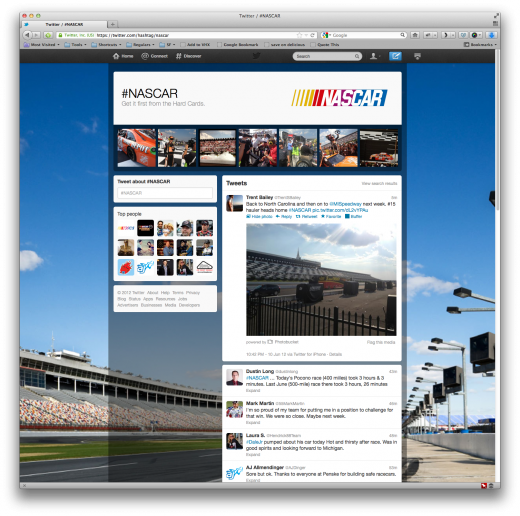Simon Says: Hashtag Pages, the (much needed) love child of Facebook & Google News
I’ve not been this excited in ages. After a while you see a lot of the same stuff getting repeated in social media. Rarely do you see a useful innovative product that people would actually use that benefits both brands and consumers.
Hashtag Pages does exactly what it says on the tin. They are a unique page designed to pull together all the media and interesting commentary around a certain hashtag. The first people to take advantage of this is #NASCAR.
The page itself is pretty. I don’t use that term lightly. I am a massive fan of web design and know how awkward it must have been for them to keep it simple and yet have all the data within reach.
These pages have massive potential to kill Google News and continue to hurt Facebook. Twitter is THE discovery platform. They know their place online and, as a result, have created a product that actually helps people discover more. They aren’t trying to expand into new territories; they know how valuable the retail space online they occupy is.
These pages could be purchased by brands to run campaigns. This produces another revenue stream for Twitter and makes discovery for the consumers on the web version of Twitter a treat.
I could see a time this could really hurt overly complex tools like Zeebox as well. I like Zeebox as a concept but the layout is designed for social media managers, not the average TV viewer as a result they’re getting slower adoption of the tool (a tool that could be very useful).
By having a simply page that people can engage in real-time discussions during a program gives Twitter the edge over Zeebox and by allowing networks to customise the experience will help give the illusion or feeling of a collective viewing experience – this has been a long time coming since on demand players have given people control of when they watch the shows they want to view.
Often people are unsure why a hashtag is trending and certain tools, like WhatTheTrend, have allow peer-to-peer explanations but with this you can get a more accurate picture of why a topic is popular.
The use of images across the top of the page feels very similar to Facebooks old Pages. They’ve taken a good idea and made it better. Additionally I love that the call-to-action isn’t in your face. There’s a simply box that encourages you to get involved if you want. All too often people shout “LIKE THIS” or “RT PLEASE” thinking that’s the best way of encouraging engagement.
A few tiny improvements would include:
- Top videos; just show us the clips people are sharing.
- Top stories; if it’s about a news article I would like to see who has published something on it.
- "Awards"; this is an odd one, but where it is trending and when. I thought it would be cool to have “#NASCAR was the Trending topic from 11am to 1pm in America (New York and California)”. This way we could see when it was popular.
We live in an awesome age where we can shut out the stories we don’t want to hear and discover the ones we do. We have greater control over the content we receive and spend our time consuming. This is both a blessing and a curse for marketing managers, but in a good way.
When you sign in to Twitter you’re greeted by a message that says "Find out what’s happening, right now, with the people and organizations you care about." We know most of our friends, sadly, don’t live the most interesting of lives which is why we get bored of hearing about what they had for breakfast on Facebook. Google News is more of a platform for general "this happened, are you interested?"
Twitter is a place where you follow the people and things that matter to you. You share content with them because you think they’ll love it as much as you do and as a result it is not only the best social network currently available, but also the one that will be around the furthest into the future, should it continue on the path it is going.
Kudos Jack, Kudos.




Comments
Calm down dear
It's not that exciting.